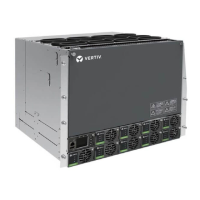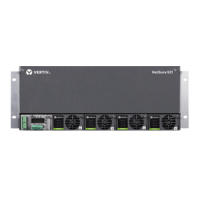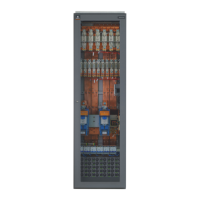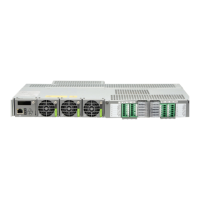Vertiv | NetSure™ 8200 Series -48 VDC Power System User Manual (UM582140000) | Rev. A
Troubleshooting Information
General
This system is designed for ease in troubleshooting and repair. The various indicators as described in “Local
Controls and Indicators” starting on page 28 and in the controller instructions are designed to isolate failure to a
specific element. Once the faulty element has been identified, refer to “Replacement Information” on page 38
and “Replacement Procedures” on page 38.
Troubleshooting Alarm Conditions on the NCU Controller
The NCU controller displays alarm conditions as listed in the “Resolving Alarms” section of the NCU controller
instructions (UM1M830BNA). Programmable external alarm relays are also available. Refer to the system
installation instructions (IM582140000) and the configuration drawing (C-drawing) supplied with your power
system documentation for your alarm relay configurations.
The NCU’s
Active Alarm
and
Alarm History
submenus allow the User to view alarm details. Refer to the NCU
controller instructions (UM1M830BNA) to access these menus.
Checking the NCU Current Limit Point after Adding or Removing a Rectifier
If a rectifier is added to the power system, the system current limit point will automatically increase by the
percentage each existing rectifier was set to provide prior to the addition.
If a rectifier is removed from the system (and the Rect Comm Fail alarm is reset), the current limit point will
remain unchanged unless the capacity of the remaining rectifiers is not sufficient to maintain the present
current limit point. If that happens, the current limit point will automatically increase to the maximum (121% of
the remaining rectifiers).
It is recommended that the current limit point be checked whenever a rectifier is added to or removed from the
power system.
When setting total rectifier current limit, the set point to each unit is the total set point divided by the number
of units. For example, if the system contains five rectifiers and the current limit is set to 150 amps then each
rectifier has a current limit set point of 30 amps. If one or more rectifiers are removed or fail it will take several
seconds for the individual set points to the remaining rectifiers to be reset. In the example given, if one rectifier
is removed the current limit set point will drop to 120 amps (30 amps times four remaining rectifiers) until the
controller can send updated set points to the remaining rectifiers. This takes a couple communication cycles
(several seconds) after which each rectifier would have a new set point of 37.5 amps for a total of 150 amps.
The total current limit of the rectifiers should not be set such that the loss of the redundant rectifiers will cause
this temporary set point to drop below the actual maximum expected load. If batteries are used on the rectifier
output, the batteries should support the load until the current limit set points can be re-established due to loss
of a rectifier.
Refer to the NCU controller instructions (UM1M830BNA) for a procedure.
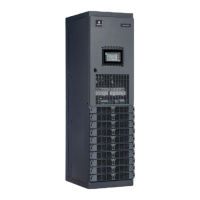
